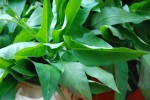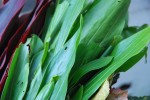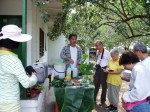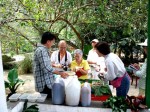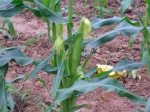Mar 05, 2012
Flowering Enhancers - I
Some of the fruit trees shall be flowering soon. Time to make some flowering enhancers. Fermented flowering enhancers provide potassium and phosphorus, plus microbes to help the plants absorb the nutrients.
We use a large plastic container with a lid.
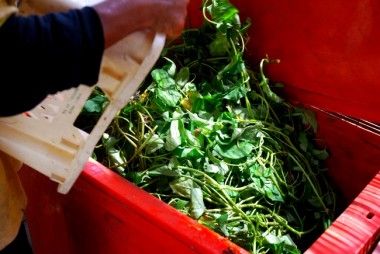
Add 10 kg of kangkung.
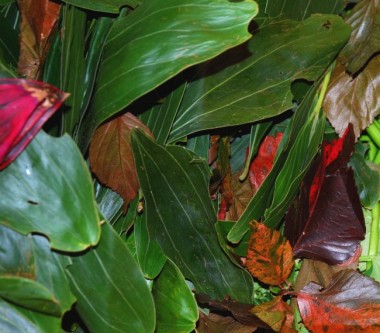
And 10 kg young acacia mangium leaves.
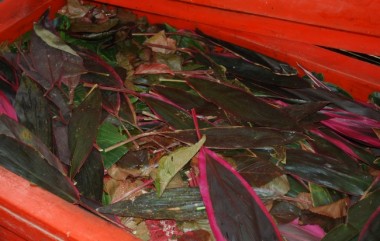
And 10 kg of red colored leaves.
Now add the potassium and phophorus:

25 kg of papaya and 25 kg of bananas.
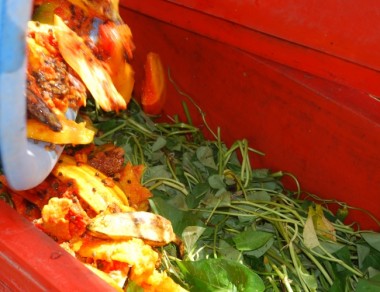
Put them together, leaves at the bottom.
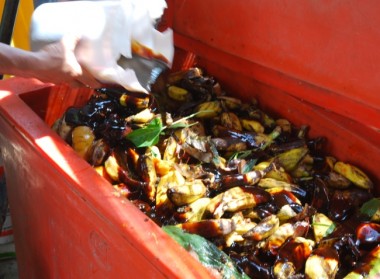
Add some molasses (agri grade, from Pertanian), about 20 kg will do.
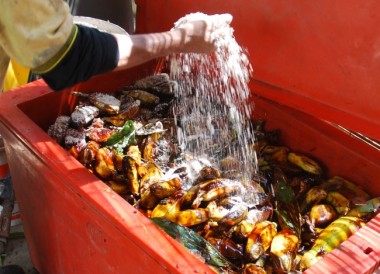
Sprinkle about 500gms quarry (granite) dust into the mix.
Cover with a plastic sheet, close the lid, and let ferment for 30 days.
(To be continued : Flowering Enhancers - II; How To Use)
14:03 Posted in Bio Nutrients, Sustainable Farming | Permalink | Comments (0) | Tags: bio nutrients, em, nature farming, sustainable farming
Aug 19, 2010
Natural Flowering Enhancers
We use what's in the farm to make our own flowering enhancers. Our dragon fruits never stop flowering and producing fruits. Our durians can be fruiting two to three weeks before others.
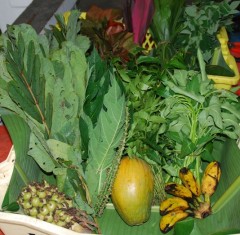


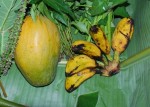
papaya 2.5
banana 2.5
Red Leaves 1.0
Kangkung young leaves 1.0
Acasia young leaves 1.0
Molasses 2.0
Quarry dust sprinkle
Put in a container until half full (or half empty, whichever). Leave for up to 60 days, covered loosely, before proceeding.
There are a few variations to use the above (which we shall call the Mother). One way is as follows:
Dilute adding 1 part filtered Mother, 1 part molasses to 20 parts water to make a Concentrate. Let the Concentrate sit for up to 7 days before diluting further required amount to use. Add one part Concentrate, one part molasses and 50 parts water for Spraying Dilution. It goes without saying you must always use unchlorinated water.
Do not spray direct from Concentrate on plants. They may wilt. Always spray diluted. Not recommended for ornamentals.
If you are using compost tea, add one part filtered Mother to 20 parts tea, and spray. Use only on fruit trees (including pitaya).
Email me direct if you encounter problems.
Notes:
1. You can find the acacia tree being grown along highways. You can use the young leaves from young trees. Acacia is an invasive, so don't plant it in your farm unless you have the patience to continually weed out the young trees.
2. Any red leaves will do.
17:45 Posted in Bio Nutrients | Permalink | Comments (6) | Tags: nature farming, organic farming, qi, qi farming, flowering enhancers, penggalak bunga
Jun 22, 2009
Workshop on Nature Q-Farming
We had a workshop on making bio nutrients and basics of Nature Q Farming on June 20th 2009. The workshop is meant for home food growers and not for commercial farmers. The objectives are to 1) introduce market gardening to urban dwellers to reduce the hold of commercial farmers over our lives, 2) to empower urban dwellers to take back some of the responsibility of producing healthy food for our children, and 3) to allow urban dwellers to have a source of income to offset increasing costs of living in the cities.
Participants were 'aligned' to the energy in the environment and taught how to harness the energy that is present, to enhance the energy and to incorporate the energy into the plants and vegetables that they are growing. By so doing, they give to the plants a part of their energy and in return the plants and microbes will multiply it many fold for them.

The field of energy around us.
Read 'The Field' by Lynne McTaggart.
For the first time, these 'die-hard' organic gardeners felt a living connection with the plants that they have been growing for years. We become a part of the plants and they become a part of us, in this cycle of passing of nutrients and living energy between one living organism to another; we are no longer 'eating' a plant instead we are sharing and exchanging living energy.
I can still remember the wonder on the face of one of the participants when he felt the microbes releasing energy at him. And I remember also the remark of another participant that he was wondering why he did not start panting after a fairly vigorous walk to some wild bamboo groves and back, as he was a heart patient.
An important part of Nature Q Farming is working with the plants and herbs and microbes that is in the environment.
Making brews of various friendly microbes to be used as intermediaries between us and the plants that we are growing.
18:11 Posted in Bio Nutrients | Permalink | Comments (5) | Tags: nature farming, organic farming, qi, qi farming
Feb 19, 2009
Tanduk Rusa - Hi-Qi, High Energy Bio Nutrient
Many visitors to our farm have wondered why we have tanduk rusa ( platycerium coronarium or staghorn fern) all over the farm. They are even found on the fruit trees.
The reason is the bacteria in the plant gives out very high beneficial energy. Trees with tanduk rusa are stronger. We harvest these bacteria and spray them on our vegetables, fruits, everywhere, for their beneficial energy:
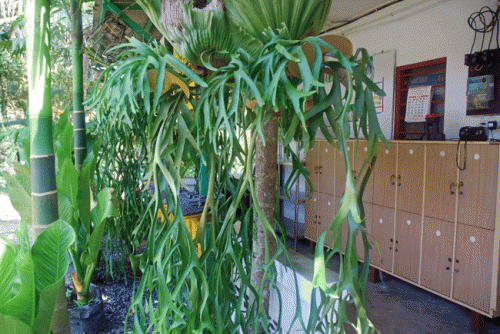

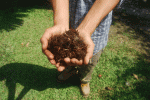
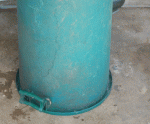
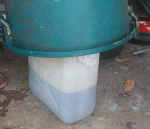
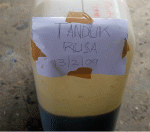
13:15 Posted in Bio Nutrients | Permalink | Comments (4) | Tags: platycerium coronarium, staghorn fern, qi, bio nutrient, foliar spray, organic, em, imo
Feb 12, 2009
Lactobacillus sp. - the Work Horse at DQ Farm
The work horse at our farm is lactobacillus sp. We use farm-caught indigenous lactobacillus and brew an Indigenous Micro Organism brew which is sprayed liberally throughout the farm to enhance the health of plants, animals and humans.
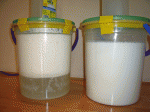
The container on the left is two days old. The curds are seperating out now as the lactobacillus starts to convert the sugars to lactic acid. The one on the right is still new.
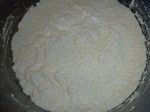
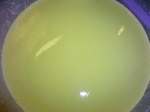
The curd (left) is removed after about a week. The curd is then fed to the animals. Some of the staff make a cheese out of the curd.
The yellowish liquid left behind is a concentrate of lactobacillus sp. which will be used to make our IMO spray.

The lactobacillus 'Mother' ready for use. The addition of raw molasses keeps the bacteria alive and prolongs the shelf life to years.
This is one of the ways how we 'disinfect' and how we keep the farm healthy.
14:31 Posted in Bio Nutrients | Permalink | Comments (4) | Tags: lactobacillus, lactic acid, em, imo
Apr 14, 2006
Nature Q-Farming
This bush of creepers were all green. Within two weeks of spraying our bio-nutrients, it started to flower abundantly.
Our high Qi compost and compost tea produces abundant crops without the use of chemicals. Here is a maize plant with four ears after we sprayed our tea. This particular type normally have one or two ears. The plant is only about 3 feet high.
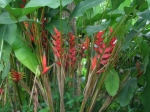
Even heliconias at our farm flower incessantly and in abundance.
15:15 Posted in Bio Nutrients | Permalink | Comments (0) | Tags: Organic Farming
Apr 10, 2006
Qi Cucumbers
We were selling our first crop of organic cucumbers and customers were asking whether we have those mini Taiwanese cucumbers. We were puzzled for a while as we thought we were selling Taiwanese minis. Now we realised that due to our bio nutrients and high qi compost, the sizes were significantly different for the same age:
21:05 Posted in Bio Nutrients | Permalink | Comments (0) | Tags: Organic Farming
Jun 22, 2005
Qi - Compost
Today at Serting, Kuala Pilah we started making compost from the goat dung in commercial quantities. The sample heap that the staff made was heating up nicely. The heap was emiting very strong qi as a result of the application of WHS Purple-1, a blend of beneficial bacteria including PNSBs; the bacteria responsible for the emiting of the qi.
I opened the points of one of the workers and sensitised his palms to the presence of qi. He felt the qi from the heap immediately. He and one other worker will be responsible for "clarifying" the energies of the bacteria in new compost.
Hi-Qi Compost are used to make sprays, to splash on roots, as fertilisers, to condition new chicken litter, etc.
22:45 Posted in Bio Nutrients | Permalink | Comments (0) | Tags: Qi Gong
Jun 21, 2005
Bio Nutrients
I am really enthused with the quality of the bio nutrients that we are producing. The amount of "qi" emanating from the liquid is amazing and plants sprayed with them seem to flower fast, faster than normal. We were pleasantly surprised when our young Colocasia Gigantea started to flower just two weeks after application of our bio nutrients. I took some photos and will put them up when I find the uplink cable which I misplaced. In formulating the bionutrients, the availability of potassium is important. I found that durians have the highest potassium amongst all the high-carbo fruits that we use. Next is of course banana, then comes the jackfruit / cempadak type fruits and finally papaya. Click here for photos of our flowering Colocasia Gigantea.
17:50 Posted in Bio Nutrients | Permalink | Comments (0) | Tags: Organic Farming








